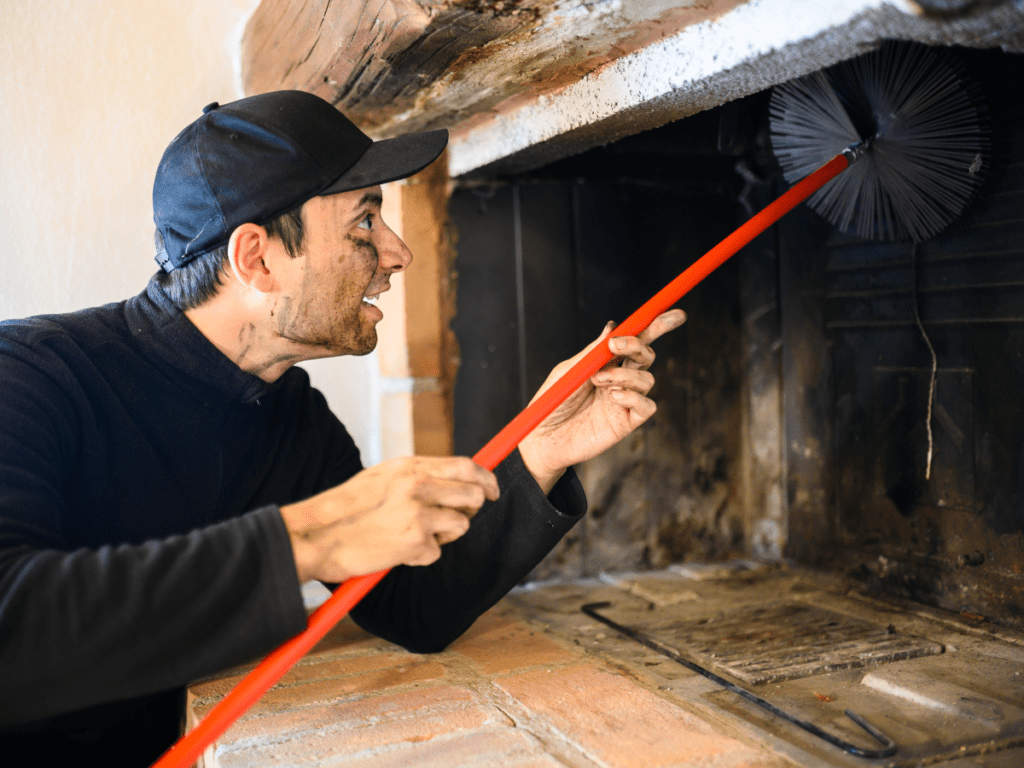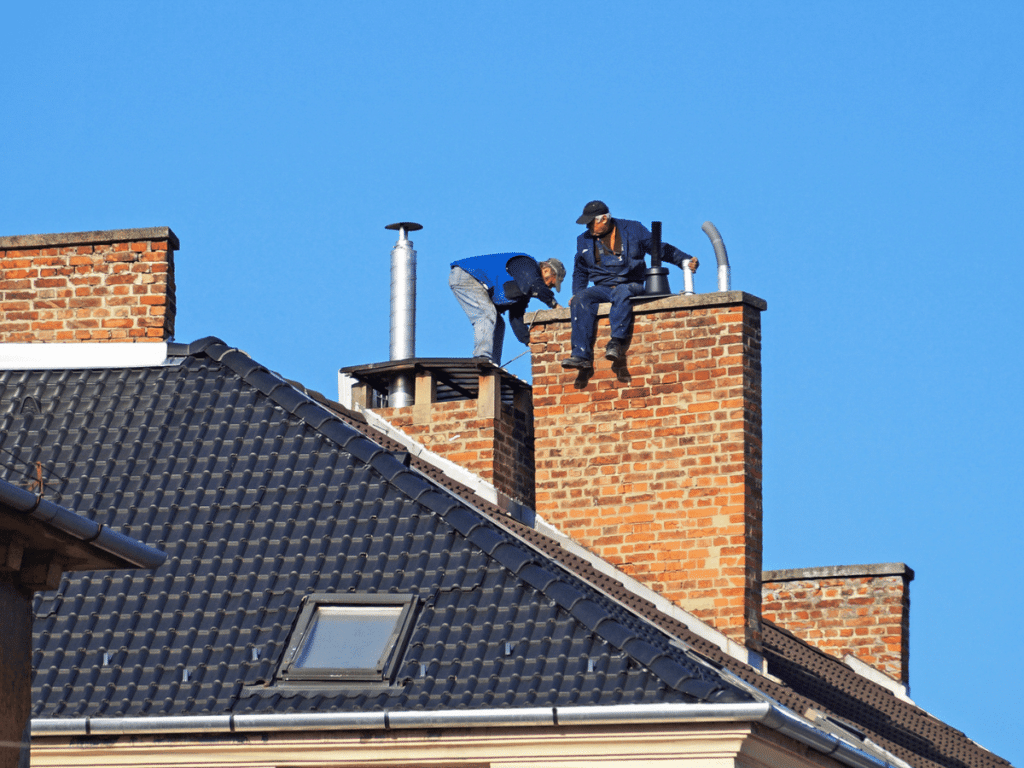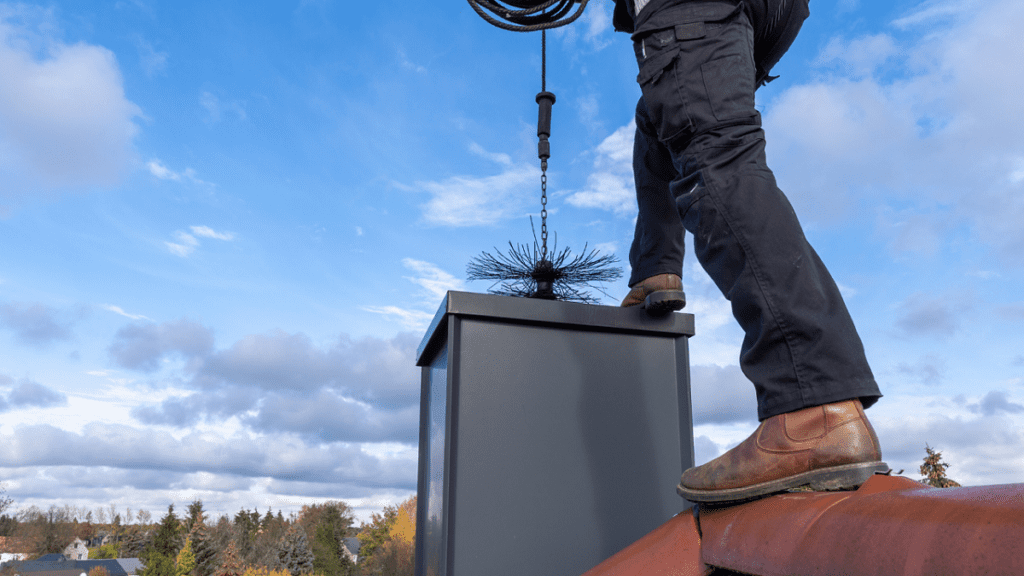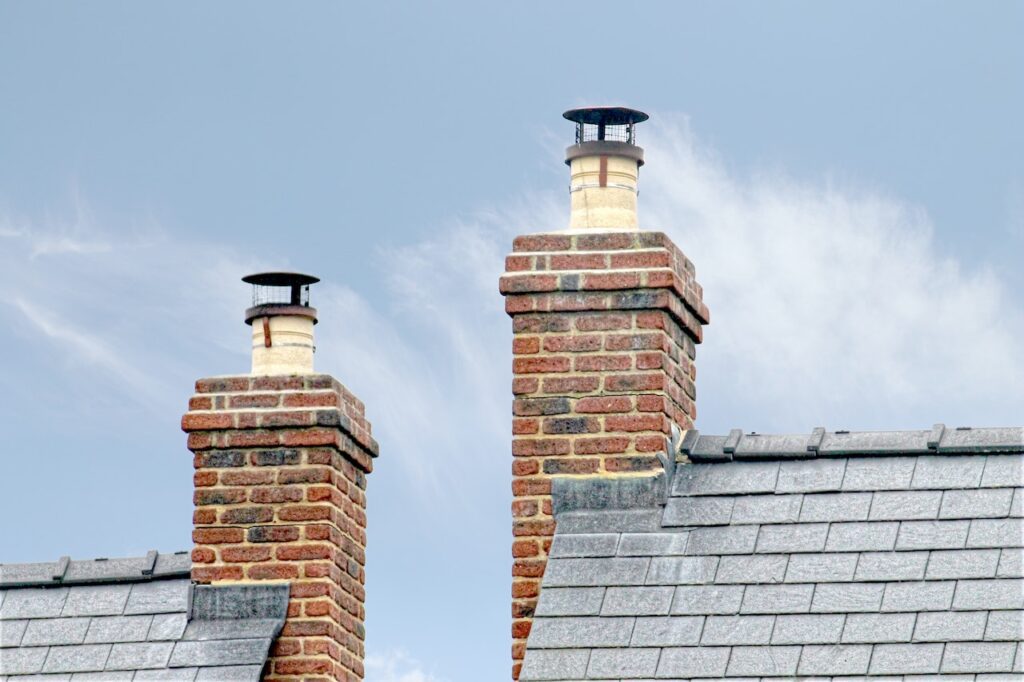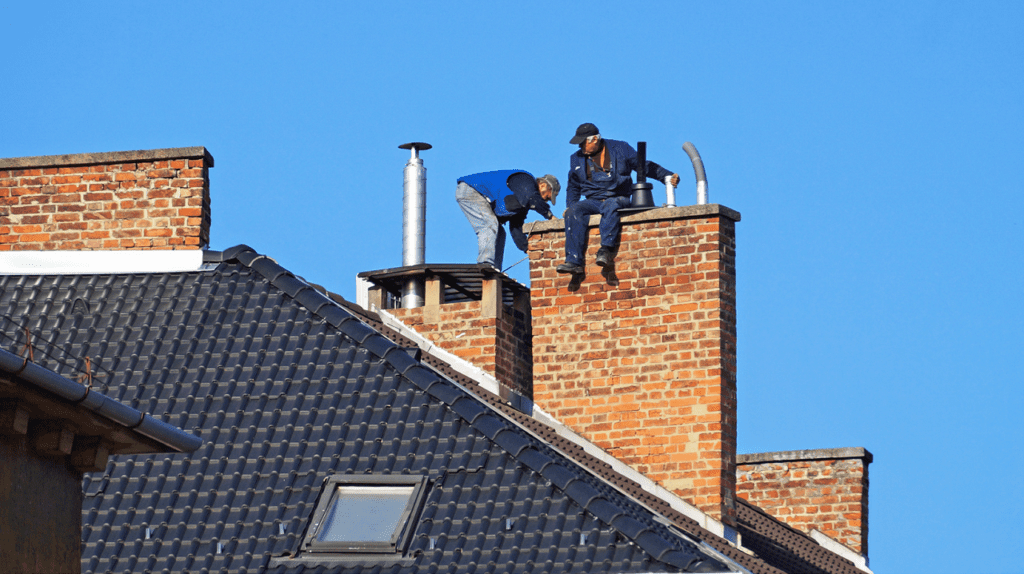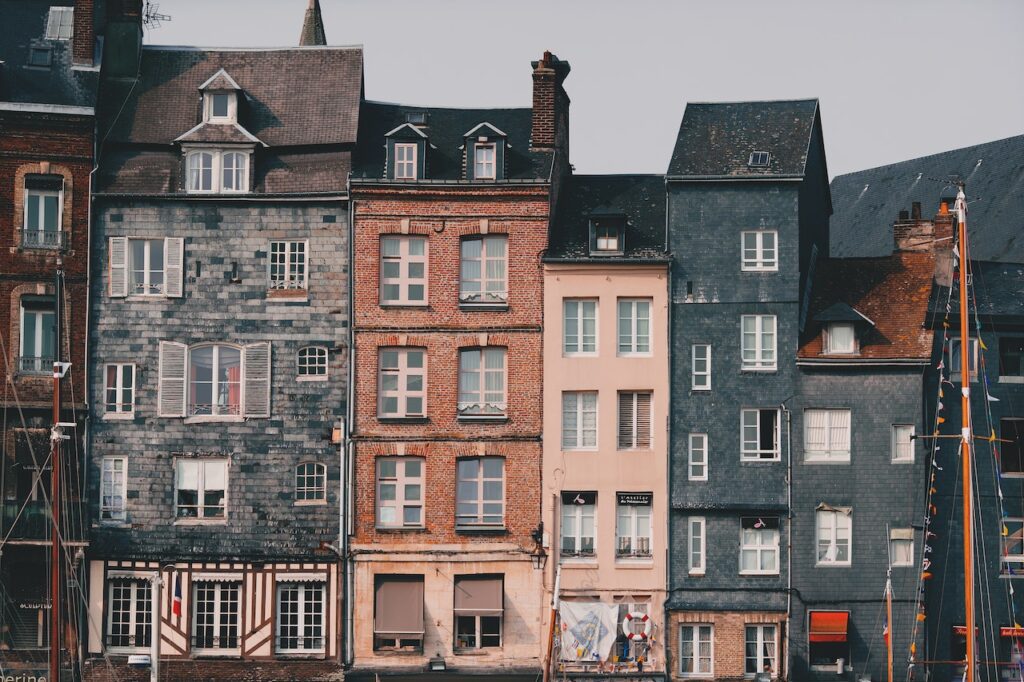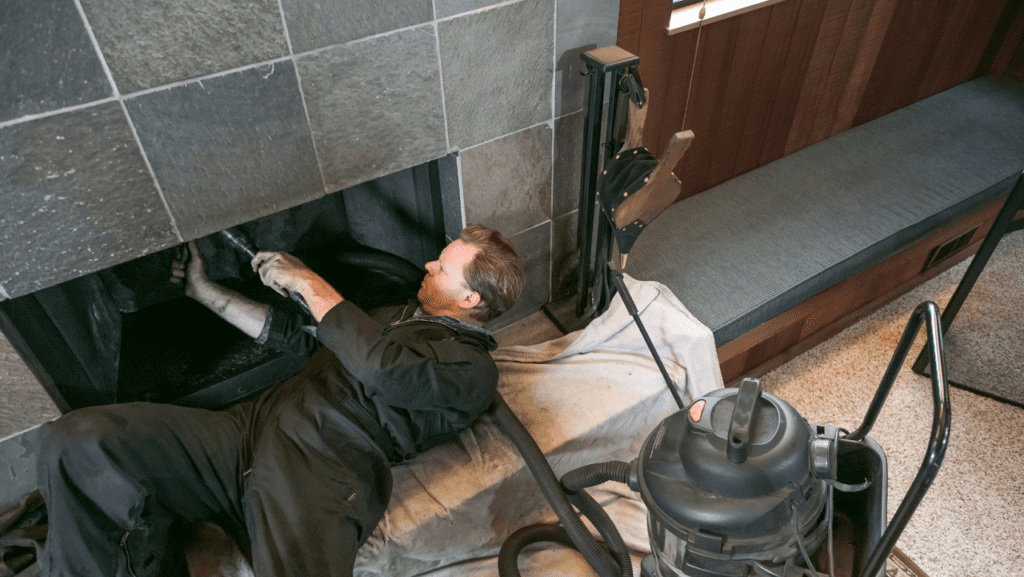
The Importance of Regular Chimney Cleaning
Chimney sweeping has been around for centuries, with the earliest recorded chimney sweep service dating back to medieval England. Back then, their job involved climbing up chimneys to clean out soot and debris. Nowadays, chimney sweeping is a much safer profession, but it’s still just as necessary.
The primary reason for chimney cleaning is safety. Over time, creosote builds up in the flue – a highly flammable substance that can ignite and cause a chimney fire.
According to the National Fire Protection Association (NFPA), there are an estimated 25,000 chimney fires each year in the United States alone. These fires can be devastating – not only destroying your home and property but also endangering the lives of you and your family.
Therefore, regular cleaning is essential to remove any dangerous buildup before it becomes a hazard. But safety isn’t the only reason to have your chimney cleaned regularly.
A cleaner chimney will also increase energy efficiency by allowing your heating appliance (such as a fireplace or wood stove) to operate more efficiently. This means you’ll use less fuel overall and save money on energy bills.
Additionally, regular cleaning can improve air quality by removing soot and other pollutants from your home’s ventilation system. So not only will you breathe easier, but you’ll also reduce potential health risks associated with poor indoor air quality.
Regular chimney cleaning isn’t just important – it’s essential for both safety and comfort in your home. Don’t put off this vital maintenance task any longer!
RELATED: The Importance of Hiring a Chimney Sweep Near Me
The Chimney Sweep Process
Step-by-Step Guide to Chimney Sweeping
When it comes to chimney sweeping, there are several steps that a professional chimney sweep will follow to ensure a thorough and efficient cleaning process.
- First, they will inspect the chimney structure for any damage or potential safety hazards. This is an important step as it allows them to identify any issues that may require repairs or further attention.
- Next, the chimney sweep will prepare the work area by laying down drop cloths and setting up their equipment. Using specialized brushes and extendable rods, they will begin removing any built-up residue such as soot, creosote, or debris from inside the chimney flue. They may also use high-powered vacuums to collect debris as it falls down into the fireplace.
- Once all of the debris has been removed, the sweep will do a final inspection of the flue to ensure that it is clean and free from obstructions. They may also perform a smoke test to confirm proper ventilation before concluding their work.
Tools and Equipment Used by Chimney Sweeps
Chimney sweeps use a variety of specialized tools and equipment during the sweeping process. One of their most important tools is the brush used for cleaning inside the flue. These brushes are typically made of stiff wire bristles attached to flexible rods that can be extended up through the entire length of the chimney.
In addition to brushes, sweeps may also use other equipment such as vacuums designed specifically for removing debris from chimneys or special cameras used for inspecting hard-to-reach areas within a flue. Safety equipment is also essential for chimney sweeps.
This includes gloves, goggles, respirators, or masks designed specifically for filtering out harmful particulates found in chimneys. Because working conditions can be tight and cramped inside a flue, safety harnesses or other safety gear may also be used to protect the sweep while they work.
Common Chimney Problems
Chimneys, like any other part of a home, are prone to problems. Over time, creosote buildup, blockages caused by debris or animals, and cracks or damage to the chimney structure can all pose serious issues.
Creosote Buildup
One of the most common issues with chimneys is creosote buildup. Creosote is a flammable substance that is created when wood burns in your fireplace or stove.
It can accumulate on the inner walls of your chimney and pose a fire hazard. A professional chimney sweep will use specialized tools to remove this buildup and ensure that your chimney is safe for use.
Blockages Caused by Debris or Animals
Debris and animals can also cause blockages in your chimney. Birds and rodents may try to make nests inside the chimney, while leaves and other debris can accumulate over time.
A blocked chimney can prevent smoke from properly venting out of your home, which can lead to dangerous levels of carbon monoxide inside your home. A professional chimney sweep will remove any blockages safely and effectively.
Cracks or Damage to the Chimney Structure
Over time, exposure to weather and other factors can cause cracks or other damage to the structure of your chimney. This damage may not be immediately visible but it can compromise the structural integrity of the entire system.
Cracks in a brick-and-mortar stack usually occur due to moisture penetrating into weakened areas where mortar has deteriorated or cracked away entirely from exposure/weather conditions over time — think lightning strikes too close for comfort during summer thunderstorms! With regular inspections by a qualified professional like a certified Chimney Sweep who understands architectural design principles (chemistry & physics), this type of problem could be avoided if spotted early enough before turning into bigger problems later on downline!
The Benefits of Regular Chimney Sweeping
Improved Air Quality in the Home
Did you know that a dirty chimney can negatively affect the air quality inside your home? When a chimney is clogged with buildup and debris, it can cause smoke, soot, and other harmful particles to circulate back into your living space.
This can be especially dangerous for individuals who suffer from respiratory issues or allergies. Regular chimney sweeping ensures that these pollutants are safely removed from your home, helping you breathe easier and enjoy a healthier living environment.
Increased Efficiency of Heating Appliances
If you use a fireplace or wood-burning stove to heat your home during the colder months, it’s essential to keep your chimney clean and free from blockages. When creosote or other debris accumulates in the flue, it restricts airflow and makes it more difficult for smoke and gases to escape.
This not only decreases the efficiency of your heating appliance but also increases the risk of carbon monoxide poisoning. By having your chimney swept regularly, you’ll ensure that air can flow freely through the flue, allowing for optimal heating performance.
Prevention of Potential Fire Hazards
Perhaps one of the most important benefits of regular chimney sweeping is its ability to prevent potential fire hazards. Creosote buildup is highly flammable and can ignite if it reaches a certain thickness. Additionally, animal nests or other blockages in the flue can limit airflow and cause smoke to back up into your home – creating an increased risk for fires.
By having your chimney cleaned on a regular basis by professionals who know what to look for – like us – you’ll minimize fire risks associated with dirty chimneys.
Overall, regular chimney sweeping provides numerous benefits beyond just keeping things looking clean – It helps improve indoor air quality while increasing heating efficiency, all while preventing potential fire hazards. If you’re overdue for chimney cleaning or have any questions about the process, don’t hesitate to give us a call.
DIY vs. Professional Chimney Sweeping
Chimney sweeping is a task that can be done by a homeowner, but it’s not always recommended. There are pros and cons to each option, and it’s important to consider them before deciding which route to take. One of the biggest advantages of DIY chimney sweeping is cost savings.
Hiring a professional can be expensive, and if you’re comfortable climbing on your roof and using the necessary tools, you could save yourself some money. Additionally, DIY chimney sweeping allows you to inspect your chimney more closely than you might otherwise be able to do.
On the other hand, there are also several disadvantages to DIY chimney sweeping that should be considered. For one thing, it can be dangerous if done improperly.
Climbing on your roof carries inherent risk, and using certain tools without proper training can lead to injury or damage to your property. Additionally, even if you’re able to sweep your chimney effectively, there may still be underlying issues that only a professional would recognize.
Pros and Cons of Each Option
There are several reasons why someone might choose professional chimney sweeping over doing it themselves. One major advantage of hiring a professional is their expertise in identifying potential problems with your chimney. A seasoned chimney sweep will know what signs of damage or wear and tear indicate that repairs need to be made before they become more serious issues.
Another advantage of hiring a professional is that they have access to higher-quality equipment than most homeowners would have at their disposal. They may also have specialized tools for removing blockages or creosote buildup that you wouldn’t find at Home Depot.
However, there are also some downsides to hiring a pro for this job as well – namely, cost. Depending on where you live and the complexity of the job at hand (e.g., multiple chimneys), hiring someone could quickly turn into an expensive proposition.
When It’s Best to Call in a Professional
In general, if you’re uncomfortable with the idea of working on your roof or using specialized chimney sweeping tools, it’s probably best to call in a professional. Similarly, if you suspect there may be damage or other issues with your chimney beyond just needing a cleaning, it’s wise to bring in an expert who can diagnose and address any problems.
Additionally, some municipalities require that certain types of properties (such as rental properties or commercial buildings) have chimneys inspected and cleaned on a regular basis by licensed professionals. If you fall into one of these categories, it’s imperative that you comply with local regulations and hire someone who meets the necessary qualifications.
Ultimately, whether you choose DIY or professional chimney sweeping depends largely on your comfort level with the task at hand. No matter which option you choose, though, make sure safety is always your top priority.
RELATED: Sweeping Away the Risks: A Comprehensive Guide to Chimney Sweep Services Near You
Frequently Asked Questions
How often should I have my chimney cleaned?
One of the most common questions that homeowners have is how often they should have their chimneys cleaned. The answer to this question can vary depending on a number of factors, including the type of fuel you use, how often you use your fireplace or stove, and the condition of your chimney.
As a general rule, it’s recommended that you have your chimney swept at least once per year. If you use your fireplace or stove frequently, or if you burn softer woods like pine which produce more creosote buildup, you may need to have your chimney swept more frequently than that.
Can I still use my fireplace during the cleaning process?
Another common question is whether or not it’s safe to use your fireplace or stove while the chimney is being cleaned. The short answer is no – it’s not safe to use your fireplace while the cleaning process is underway. When a professional chimney sweep comes to clean your chimney, they will need access to both ends of the flue in order to do their job properly.
This means opening up access panels and using specialized brushes and tools inside the flue itself. For safety reasons, it’s important that there are no fires burning in your hearth while this work is being done.
What should I do if I suspect a blockage or other issue with my chimney?
If you suspect that there might be an issue with your chimney – such as a blockage caused by debris or animals – it’s important to take action right away. A blocked or damaged chimney can be extremely dangerous, as it can lead to carbon monoxide buildup and potential fire hazards inside your home.
If you notice any signs of blockage such as reduced airflow from your fireplace or stove, strange smells coming from the chimney, or visible debris inside the flue, you should contact a professional chimney sweep immediately. They can inspect your chimney and recommend any necessary repairs or cleaning services to keep your home safe and comfortable all year round.
What is the difference between chimney cleaning and sweeping?
While the terms “chimney cleaning” and “chimney sweeping” are often used interchangeably, sweeping typically refers to the process of removing soot and creosote from the chimney’s interior, whereas cleaning might involve a more comprehensive service, such as inspection for damage, cleaning the chimney cap, and ensuring the overall condition of the chimney is good.
What will a chimney sweep do?
A chimney sweep will clean soot, creosote, and any obstructions from your chimney, ensuring it is safe to use; they may also inspect the chimney for any potential damage and offer advice on proper usage and maintenance.
What is a chimney sweeper called?
A professional who cleans and maintains chimneys is typically referred to as a chimney sweep or chimney sweeper.
Why were chimney sweeps needed?
Chimney sweeps were needed, particularly during the Industrial Revolution, because the heavy use of coal in households led to the build-up of soot in the chimneys, which posed a fire hazard; sweeps would clean these chimneys, reducing the risk of chimney fires.
When should you sweep a chimney?
It is generally recommended to sweep a chimney at least once a year, particularly before the winter season when fireplaces are most frequently used, to ensure it’s free of soot, creosote, and any potential blockages.
How long does a chimney sweep take?
The time it takes to sweep a chimney can vary significantly based on its condition, size, and the amount of soot or creosote present, but on average, a professional chimney sweep might spend anywhere between 45 minutes to 2 hours on the task.
Conclusion
Chimney sweeping is an essential service that homeowners need to keep their chimneys in good condition. Regular maintenance of chimneys can prevent the buildup of creosote, blockages, and other issues that can lead to potential fire hazards. Additionally, it improves air quality in the home and increases the efficiency of heating appliances.
It’s important to hire a professional chimney sweep for this job as they have the tools and expertise required to do a thorough cleaning job. However, homeowners can also take steps to maintain their chimneys themselves by monitoring for signs of damage or debris accumulation between professional cleanings.
By doing so, they can ensure their homes are safe and their chimneys are functioning efficiently throughout the year. Chimney sweep service is not only necessary for ensuring safety but also for maintaining good indoor air quality and improving heating appliance performance.
With regular maintenance from professionals and responsible upkeep from homeowners, we can all enjoy a warm fire without having to worry about potential hazards or inefficiencies within our chimney systems. Stay safe and warm!

